MENU
The Electronic Scholarly Publishing Project: Providing access to classic scientific papers and other scholarly materials, since 1993. More About: ESP | OUR CONTENT | THIS WEBSITE | WHAT'S NEW | WHAT'S HOT
Comparative Timelines
The ESP Timeline (one of the site's most popular features) has been completely updated to allow the user to select (using the timeline controls above each column) different topics for the left and right sides of the display.
Select:
New Left Column
New Left Column
Dates
Decade
New Right Column
New Right Column
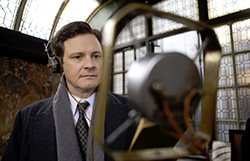 The King's Speech wins Academy Award for best picture. The 2010 film was another unlikely subject matter: The king of England needs to eliminate his stutter. But it became a touching film about a man overcoming personal obstacles, family love, and friendship. Colin Firth's acting, Tom Hooper's direction, and David Seidler's script all won Oscars and got huge ovations from the Oscar audience.
The King's Speech wins Academy Award for best picture. The 2010 film was another unlikely subject matter: The king of England needs to eliminate his stutter. But it became a touching film about a man overcoming personal obstacles, family love, and friendship. Colin Firth's acting, Tom Hooper's direction, and David Seidler's script all won Oscars and got huge ovations from the Oscar audience.
2010
(no entry for this year)
 The Artist wins Academy Award for best picture. This was yet another unlikely winner: a black-and-white film without dialogue, set in 1920s Hollywood, and made by French filmmakers. It was the first best picture Oscar winner to be set in the movie industry and only the second silent film, after original winner Wings.
The Artist wins Academy Award for best picture. This was yet another unlikely winner: a black-and-white film without dialogue, set in 1920s Hollywood, and made by French filmmakers. It was the first best picture Oscar winner to be set in the movie industry and only the second silent film, after original winner Wings.
2011
(no entry for this year)
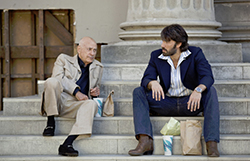 Argo wins Academy Award for best picture. The film about the true-life rescue of hostages in Tehran, was directed by Ben Affleck; it became the first movie in 23 years to take top prize without a director nomination. It was also the fourth film in a decade with key scenes shot in Los Angeles. And it has one other major distinction: Variety plays an important role in a plot twist.
Argo wins Academy Award for best picture. The film about the true-life rescue of hostages in Tehran, was directed by Ben Affleck; it became the first movie in 23 years to take top prize without a director nomination. It was also the fourth film in a decade with key scenes shot in Los Angeles. And it has one other major distinction: Variety plays an important role in a plot twist.
2012
(no entry for this year)
 Photograph by Hilda Clayton: Photographer records her own death. On 2 July 2013, Spec. Hilda Clayton, a combat photographer in the U.S. Army, was documenting a live-fire exercise in Afghanistan when a mortar tube accidentally exploded in front of her. This picture records the explosion that killed her, the soldier in the image, and three others,
Photograph by Hilda Clayton: Photographer records her own death. On 2 July 2013, Spec. Hilda Clayton, a combat photographer in the U.S. Army, was documenting a live-fire exercise in Afghanistan when a mortar tube accidentally exploded in front of her. This picture records the explosion that killed her, the soldier in the image, and three others,
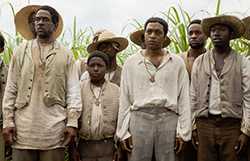 12 Years a Slave wins Academy Award for best picture. The film about U.S. slavery was directed by Steve McQueen and written by John Ridley, based on the memoirs of Solomon Northup, a free man who was kidnapped and sold into slavery. The film earned an impressive $188 million worldwide, with 70% of that from outside the U.S. It earned three Oscars out of nine nominations and Brad Pitt was among the producers.
12 Years a Slave wins Academy Award for best picture. The film about U.S. slavery was directed by Steve McQueen and written by John Ridley, based on the memoirs of Solomon Northup, a free man who was kidnapped and sold into slavery. The film earned an impressive $188 million worldwide, with 70% of that from outside the U.S. It earned three Oscars out of nine nominations and Brad Pitt was among the producers.
2013
(no entry for this year)
 Birdman or (The Unexpected Virtue of Ignorance) wins Academy Award for best picture. The film, about a faded star attempting a stage comeback, was technically dazzling, appearing to have been shot in one continuous take. Not everyone loved the Alejandro Inarritu-directed comedy-drama and some were mystified by the ending. But the people who liked it REALLY liked it.
Birdman or (The Unexpected Virtue of Ignorance) wins Academy Award for best picture. The film, about a faded star attempting a stage comeback, was technically dazzling, appearing to have been shot in one continuous take. Not everyone loved the Alejandro Inarritu-directed comedy-drama and some were mystified by the ending. But the people who liked it REALLY liked it.
2014
(no entry for this year)
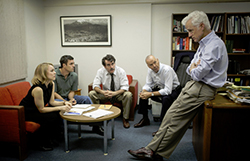 Spotlight wins Academy Award for best picture. The fact-based story, about a Boston newspaper team, won two Oscars, for film and screenplay (by Josh Singer and director Tom McCarthy). It marked the second consecutive win for a film starring Michael Keaton.
Spotlight wins Academy Award for best picture. The fact-based story, about a Boston newspaper team, won two Oscars, for film and screenplay (by Josh Singer and director Tom McCarthy). It marked the second consecutive win for a film starring Michael Keaton.
2015
(no entry for this year)
 Moonlight wins Academy Award for best picture. The Moonlight win was a record-breaker in Academy history: It was the first film with an all-black cast, with many black artists behind the camera, and was the first gay-themed film to take the top prize. It was also at the center of Oscar's biggest snafu: Due to a mix-up in envelopes, Faye Dunaway announced La La Land as the winner, and it took a few minutes before the real Moonlight victory was announced.
Moonlight wins Academy Award for best picture. The Moonlight win was a record-breaker in Academy history: It was the first film with an all-black cast, with many black artists behind the camera, and was the first gay-themed film to take the top prize. It was also at the center of Oscar's biggest snafu: Due to a mix-up in envelopes, Faye Dunaway announced La La Land as the winner, and it took a few minutes before the real Moonlight victory was announced.
2016
(no entry for this year)
 Painting by Jean-Michel Basquiat: Untitled, sells for a record-breaking $110.5 million at auction — the highest sum ever paid at auction for a U.S.-produced artwork. The work was created in 1982 when the artist was 21 years old. Until shortly before Thursday's auction, it hadn't been shown in public since a private collector bought it for $19,000 in 1984.
Painting by Jean-Michel Basquiat: Untitled, sells for a record-breaking $110.5 million at auction — the highest sum ever paid at auction for a U.S.-produced artwork. The work was created in 1982 when the artist was 21 years old. Until shortly before Thursday's auction, it hadn't been shown in public since a private collector bought it for $19,000 in 1984.
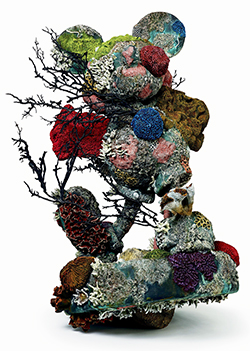 Sculptures by Damien Hirst: Treasures From the Wreck of the Unbelievable — his first major show of new work since the financial collapse of 2009. The collection is being shown at Palazzo Grassi and Punta della Dogana, the two Venetian venues of the Pinault Collection. The conceit behind the show is that the works were originally a stash of ancient treasures, lost in a shipwreck nearly 2000 years ago, and recently recovered. The long-lost treasures include giant sculptures of sea monsters encrusted with coral and semiprecious stones; golden monkeys, unicorns and tortoises; as well as a goddess whose face looks oddly like Kate Moss, a marble pharaoh that resembles Pharrell Williams and a bronze statue of Mickey Mouse (pictured), covered with centuries of marine growth.
Sculptures by Damien Hirst: Treasures From the Wreck of the Unbelievable — his first major show of new work since the financial collapse of 2009. The collection is being shown at Palazzo Grassi and Punta della Dogana, the two Venetian venues of the Pinault Collection. The conceit behind the show is that the works were originally a stash of ancient treasures, lost in a shipwreck nearly 2000 years ago, and recently recovered. The long-lost treasures include giant sculptures of sea monsters encrusted with coral and semiprecious stones; golden monkeys, unicorns and tortoises; as well as a goddess whose face looks oddly like Kate Moss, a marble pharaoh that resembles Pharrell Williams and a bronze statue of Mickey Mouse (pictured), covered with centuries of marine growth.
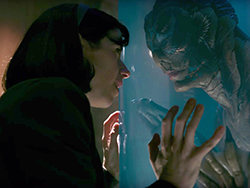 The Shape of Water wins Academy Award for best picture. Fox Searchlight's The Shape of Water centers on the 1962 romance between a mute janitor and an Amazonian fish-man. It's an eccentric premise, but voters were swept away by the dreamlike visuals, the heart-on-your-sleeve emotions, and the subtle social commentary of the film. It was a tight Oscar race, but voters seemed happy to salute Guillermo del Toro, one of the best-liked and most respected artists working in film.
The Shape of Water wins Academy Award for best picture. Fox Searchlight's The Shape of Water centers on the 1962 romance between a mute janitor and an Amazonian fish-man. It's an eccentric premise, but voters were swept away by the dreamlike visuals, the heart-on-your-sleeve emotions, and the subtle social commentary of the film. It was a tight Oscar race, but voters seemed happy to salute Guillermo del Toro, one of the best-liked and most respected artists working in film.
2017
(no entry for this year)
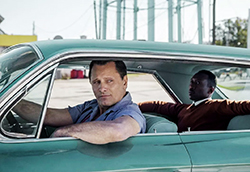 Green Book wins Academy Award for best picture. Green Book is a 2018 American biographical drama film directed by Peter Farrelly. Set in 1962, the film is inspired by the true story of a tour of the Deep South by African-American classical and jazz pianist Don Shirley (Mahershala Ali) and Italian-American bouncer Tony Vallelonga (Viggo Mortensen) who served as Shirley's driver and bodyguard. The film was written by Farrelly, Brian Hayes Currie and Vallelonga's son, Nick Vallelonga, based on interviews with his father and Shirley, as well as letters his father wrote to his mother. The film is named after The Negro Motorist Green Book, a mid-20th century guidebook for African-American travelers written by Victor Hugo Green, to help them find motels and restaurants that would accept them.
Green Book wins Academy Award for best picture. Green Book is a 2018 American biographical drama film directed by Peter Farrelly. Set in 1962, the film is inspired by the true story of a tour of the Deep South by African-American classical and jazz pianist Don Shirley (Mahershala Ali) and Italian-American bouncer Tony Vallelonga (Viggo Mortensen) who served as Shirley's driver and bodyguard. The film was written by Farrelly, Brian Hayes Currie and Vallelonga's son, Nick Vallelonga, based on interviews with his father and Shirley, as well as letters his father wrote to his mother. The film is named after The Negro Motorist Green Book, a mid-20th century guidebook for African-American travelers written by Victor Hugo Green, to help them find motels and restaurants that would accept them.
2018
(no entry for this year)
 Parasite wins Academy Award for best picture. Parasite is a 2019 South Korean black comedy thriller film directed by Bong Joon-ho. It follows the members of a poor family who scheme to become employed by a wealthy family by infiltrating their household and posing as unrelated, highly qualified individuals. Parasite premiered at the 2019 Cannes Film Festival on 21 May 2019, where it became the first South Korean film to win the Palme d'Or. Among its numerous accolades, Parasite won a leading four awards at the 92nd Academy Awards: Best Picture, Best Director, Best Original Screenplay, and Best International Feature Film. It became the first South Korean film to receive Academy Award recognition, as well as the first film not in English to win Best Picture. It also won the Golden Globe Award for Best Foreign Language Film and the BAFTA Award for Best Film Not in the English Language, and became the first film not in English to win the Screen Actors Guild Award for Outstanding Performance by a Cast in a Motion Picture.
Parasite wins Academy Award for best picture. Parasite is a 2019 South Korean black comedy thriller film directed by Bong Joon-ho. It follows the members of a poor family who scheme to become employed by a wealthy family by infiltrating their household and posing as unrelated, highly qualified individuals. Parasite premiered at the 2019 Cannes Film Festival on 21 May 2019, where it became the first South Korean film to win the Palme d'Or. Among its numerous accolades, Parasite won a leading four awards at the 92nd Academy Awards: Best Picture, Best Director, Best Original Screenplay, and Best International Feature Film. It became the first South Korean film to receive Academy Award recognition, as well as the first film not in English to win Best Picture. It also won the Golden Globe Award for Best Foreign Language Film and the BAFTA Award for Best Film Not in the English Language, and became the first film not in English to win the Screen Actors Guild Award for Outstanding Performance by a Cast in a Motion Picture.
2019
(no entry for this year)
ESP Quick Facts
ESP Origins
In the early 1990's, Robert Robbins was a faculty member at Johns Hopkins, where he directed the informatics core of GDB — the human gene-mapping database of the international human genome project. To share papers with colleagues around the world, he set up a small paper-sharing section on his personal web page. This small project evolved into The Electronic Scholarly Publishing Project.
ESP Support
In 1995, Robbins became the VP/IT of the Fred Hutchinson Cancer Research Center in Seattle, WA. Soon after arriving in Seattle, Robbins secured funding, through the ELSI component of the US Human Genome Project, to create the original ESP.ORG web site, with the formal goal of providing free, world-wide access to the literature of classical genetics.
ESP Rationale
Although the methods of molecular biology can seem almost magical to the uninitiated, the original techniques of classical genetics are readily appreciated by one and all: cross individuals that differ in some inherited trait, collect all of the progeny, score their attributes, and propose mechanisms to explain the patterns of inheritance observed.
ESP Goal
In reading the early works of classical genetics, one is drawn, almost inexorably, into ever more complex models, until molecular explanations begin to seem both necessary and natural. At that point, the tools for understanding genome research are at hand. Assisting readers reach this point was the original goal of The Electronic Scholarly Publishing Project.
ESP Usage
Usage of the site grew rapidly and has remained high. Faculty began to use the site for their assigned readings. Other on-line publishers, ranging from The New York Times to Nature referenced ESP materials in their own publications. Nobel laureates (e.g., Joshua Lederberg) regularly used the site and even wrote to suggest changes and improvements.
ESP Content
When the site began, no journals were making their early content available in digital format. As a result, ESP was obliged to digitize classic literature before it could be made available. For many important papers — such as Mendel's original paper or the first genetic map — ESP had to produce entirely new typeset versions of the works, if they were to be available in a high-quality format.
ESP Help
Early support from the DOE component of the Human Genome Project was critically important for getting the ESP project on a firm foundation. Since that funding ended (nearly 20 years ago), the project has been operated as a purely volunteer effort. Anyone wishing to assist in these efforts should send an email to Robbins.
ESP Plans
With the development of methods for adding typeset side notes to PDF files, the ESP project now plans to add annotated versions of some classical papers to its holdings. We also plan to add new reference and pedagogical material. We have already started providing regularly updated, comprehensive bibliographies to the ESP.ORG site.
ESP Picks from Around the Web (updated 06 MAR 2017 )
Old Science

Weird Science

Treating Disease with Fecal Transplantation
Fossils of miniature humans (hobbits) discovered in Indonesia

Dinosaur tail, complete with feathers, found preserved in amber.
Astronomy

Mysterious fast radio burst (FRB) detected in the distant universe.